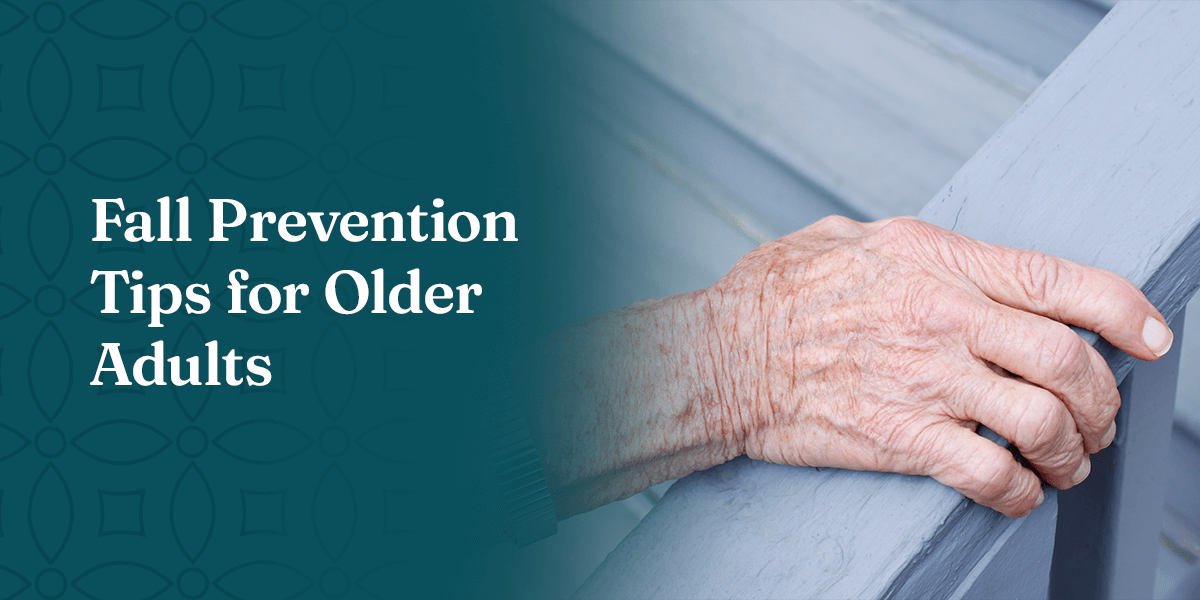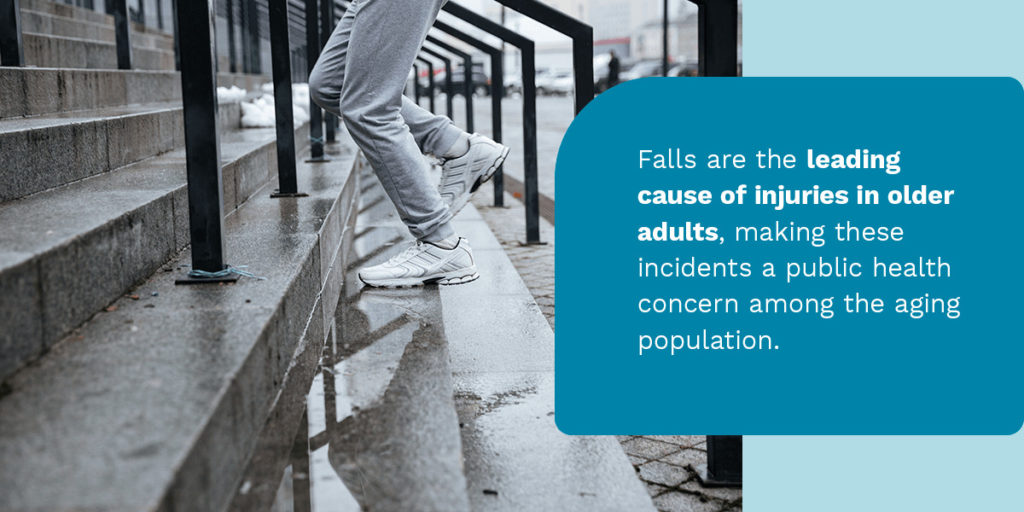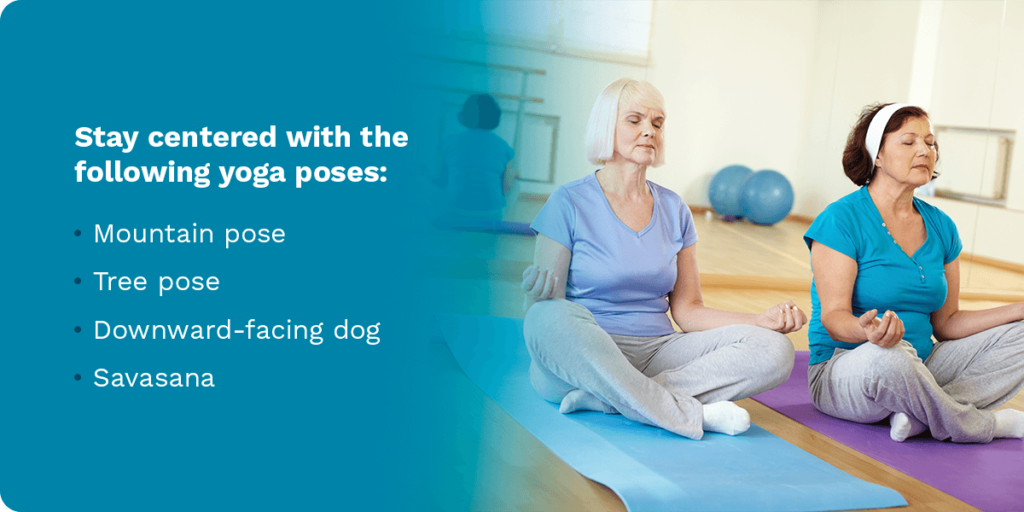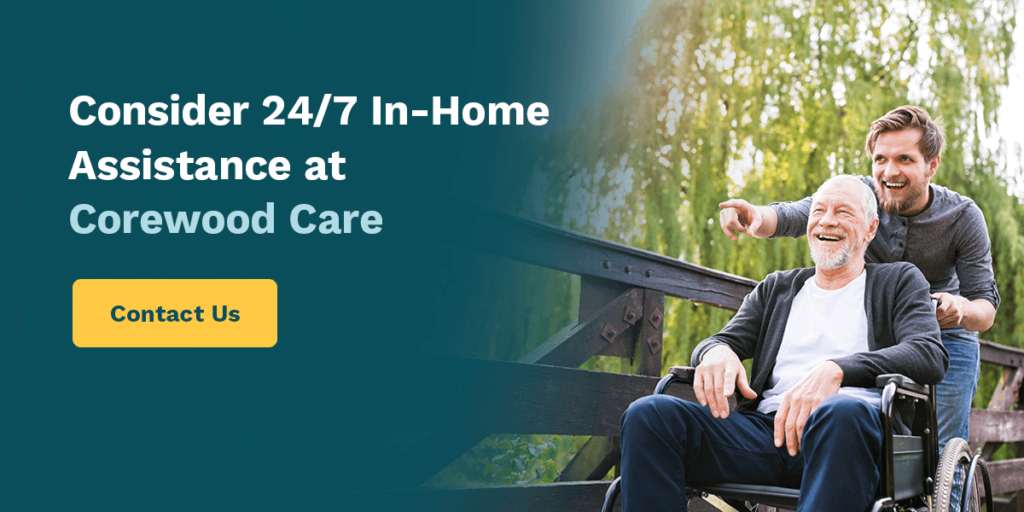Fall Prevention Tips for Older Adults

Founder & CEO

Table of Contents
Experts estimate that one out of every four older adults fall each year in the United States. As we grow older, physical changes, medications and health conditions can make falls more likely and lead to hip fractures, cuts and even severe or fatal head injuries.
Fortunately, if you have an older friend or family member, you can be proactive to prevent falls and keep them safe. Fall prevention for older adults starts with fall-proofing their living space, working on balance and strength training and making other simple yet effective changes.
Try out a few of these tips to help an older adult in your life avoid injuries and maintain a healthier, happier lifestyle.
Potential Fall Risks for Older Adults
Many variables can cause falls in older adults. The risk is often related to a combination of factors, such as:
- Eyesight, reflexes and hearing aren’t as strong as we age.
- Certain conditions like heart disease, diabetes and thyroid problems can affect balance and cause falls.
- Cognitive impairments or types of dementia can put older adults at higher risk of falling.
- Age-related loss of muscle mass, problems with gait and balance.
- Low blood pressure caused by getting up from lying down or sitting up can increase the risk of falling.
- Some medications have side effects like dizziness or confusion that can increase a person’s risk of falling.
- Safety hazards around the home can lead to falls.
Fall Prevention Techniques

Falls are the leading cause of injuries in older adults, making these incidents a public health concern among the aging population. To minimize the risks and help someone close to your stay safe, try the following fall prevention techniques:
1. Regular Exercise and Activity
Some exercises can reduce the risk of falling. Exercises focusing on balance and strength training can significantly help reduce the risk of falling. Remember that certain physical activities should only be reserved for older adults with a low risk of falling who can stand independently without support.
Lifting weights can help older adults improve their muscle strength, which often diminishes with age. Resistance bands are another option to help with exercises. A sit-to-stand exercise can also help improve balance and body mechanics to reduce falls.
While exercise can help prevent falls, it’s equally beneficial for older adults’ physical and mental health. Consult with their physician to ensure they get the recommended amount of physical activity each week.
2. Try Yoga
Yoga is another way to help older adults prevent falls, with many poses focusing on improving strength and balance. Yoga can also help people stay mindful and enhance cognitive function. You can help an older adult in your life prevent falls, relieve stress and stay centered with the following yoga poses:
- Mountain pose: This yoga pose helps with balance and grounding. Older adults should stand tall with their heels together, drawing a deep breath in and out while relaxing their shoulders.
- Tree pose: This pose is excellent for abdominal and leg strength, helping older adults with balance and focus. Have them stand tall and place one foot on their opposite inner thigh, either below or above the knee. Next, have them open their leg to the side and bring their hands to a prayer position to hold for five breaths.
- Downward-facing dog: This position is excellent for flexibility, joint health and all-over body strength. Older adults should go on their hands and knees before shifting downward and lifting the hips up and back to form a triangle with the body. Next, have them use their core strength and legs to bring the weight back as much as possible, lowering down after five to eight breaths.
- Savasana: This pose can help reset the nervous system and restore a sense of calm to the mind and body. Have your family member lie on their back in final relaxation, allowing the floor to support them. Instruct them to relax the muscles and take deep breaths as long as needed.

3. Use Assistance Devices and Alarms
Fall prevention for older adults often starts with installing alarms and assistive devices in the home. Older adults can utilize several devices to prevent falls or call for help in case they occur. These individuals can also wear monitors or install them in the home, making contacting and receiving emergency help easier.
Other assistive devices to fall-proof a home include:
- Voice commands for smart hubs: Voice control can benefit older adults. Smart hubs compile the smart devices in the home so they can control them through voice automation from one hub. Older adults can make and take calls, stream TV shows and even control the lights through voice commands. The device can reduce the number of times an older adult uses the stairs or moves around the home, reducing their risk of falling.
- Stairlifts: For many older adults, stairlifts make an excellent investment. As we age, climbing stairs is more dangerous as we lose muscle strength. With a stairlift, your older family member can ascend and descend stairs safely and without assistance.
- Programmable smart lights: Lighting is essential to prevent falls. With smart lights, older adults can control the brightness of a room or walkway with a remote. They can also program the lights to turn on as they enter certain areas.
- Canes and walkers: Assistive devices like canes and walkers can help your older family member feel steady as they walk, helping to prevent falls. These devices are accommodating in unfamiliar places or where walkways are uneven.
4. Wear Sensible Shoes
It’s essential to wear the proper footwear to prevent falls. High heels, shoes with slick soles and floppy slippers can all lead to trips or stumbles. Instead, have your family member opt for adequately fitting, sturdy, flat shoes with nonskid soles. Sensible shoes that are correctly fitted can also reduce joint pain.
5. Keep Hands Free
Older adults should leave their hands free while walking to ensure they can catch themselves if they trip or stumble. Shoulder bags, fanny packs or backpacks can also help keep the hands free, so they can hold onto railings while walking in or outside the home. When grocery shopping alone, ensure they follow the same protocols with shoulder bags to carry groceries and heavier items.
6. Maintain Optimal Health
Identifying and treating health risk factors is also essential for preventing falls. For instance, treating blood pressure, calcium supplementation, vitamin D and visual impairments is crucial.
Older adults can also take preventive health measures such as:
- Having eyes and hearing tested: Even minor changes in hearing and sight are linked to an increased risk for falls. It’s essential for older adults to wear their glasses or contacts as their doctors advise and wear hearing aids correctly.
- Getting plenty of sleep: Being tired or fatigued can lead to more falls. That’s why older adults need to get plenty of rest. Experts recommend these individuals get at least seven to nine hours of sleep a night.
- Discussing side effects of medications: Older adults need to learn about and discuss any side effects of medications they take. For instance, if a medicine makes them tired or dizzy, they should tell their health care provider.
- Avoiding or limiting alcohol: Consuming too much alcohol can cause balance issues and falls, making it essential for older adults to avoid or limit alcohol use.
7. Lighten Your Living Space
One way to fall-proof a home is by lighting up the living space. A brightly lit home can help them avoid tripping on objects that are hard to see. This is especially crucial for older adults with visual impairments. Lighten a space by:
- Placing night lights along hallways and in the bedrooms and bathrooms.
- Placing lamps close to bedsides.
- Making clear paths to light switches.
- Trading traditional switches for illuminated or glow-in-the-dark switches.
- Installing lights in stairways.
- Storing flashlights in easy-to-find places in case of power outages.
8. Stay Inside During Severe Weather
Another vital fall prevention technique for adults is to stay inside in the event of bad weather. Some community services will provide 24-hour delivery of groceries and prescriptions, while many take orders over the phone. If you have an older friend or family member, encourage them to stay inside to prevent falling due to heavy rain, snowfall or ice.
9. Talk to Your Health Care Provider
While many older adults fall yearly, research shows fewer than half discuss it with their doctors. Older adults should make appointments with their health care provider to help avoid fatal or nonfatal injuries. The doctor may assess their risk and discuss fall prevention techniques to help. They may want to discuss the following:
- Medications: It’s helpful to bring a list of prescriptions or nonprescription drugs and supplements to the doctor. That way, they can review the medications for side effects or interactions that could increase a person’s risk of falling.
- Any previous falls: If an older adult close to you falls, have them write down the details, including when, where and how they fell. They should also discuss instances where they almost fell and managed to grab support in time. Details like these can help your health provider develop specific fall prevention techniques.
- Health conditions: Specific ear and eye disorders might increase an older adult’s risk of falls. They should always discuss these health conditions and any dizziness, shortness of breath or foot issues that might occur while walking. That way, health providers can evaluate muscle strength, walking style and balance to help come up with a plan to prevent falls.
How to Fall-Proof a Home
Whether it’s electrical cords, slippery floors or uneven stairs, many factors in the home can increase a person’s risk of falling. Therefore, fall prevention for older adults should start with creating a safe, hazard-free living space. If you have an older family member, look around your home for anything that could cause a slip, tumble or fall.
To fall-proof your home, do the following:
- Store necessities within easy reach: Older adults should keep items like clothing, medication and food within easy reach. That way, they can avoid falls by attempting to reach for objects out of reach. This can also reduce joint strain, ensuring more convenient, comfortable access to their needs.
- Repair flooring: Be sure to repair any loose wooden floorboards and carpeting immediately. Reduce trip hazards to help an older family member navigate the house safely and take note of any uneven flooring.
- Restrain pets: If you have pets, ensure they can’t get underfoot, as this can quickly lead to trips and falls. You might use leashes or baby gates to keep them out of the bathroom and off the stairs to prevent your family member from falling. Training them is another way to keep them away from their feet while walking inside and outdoors.
- Remove loose items from the floor: Be sure to secure loose throw rugs with double-faced tape or slip-resistant backing to reduce trip hazards in the home. Also, keep smaller items off the floor, like newspapers, boxes and electrical cords. Move larger ones, like coffee tables and plant stands, away from high-traffic areas.
- Illuminate dark areas: We rely on our vision to keep balance. Walking in a dark room can increase the risk of falling. That’s why it’s essential to brighten the areas where older adults might walk after dark, including hallways, stairs and basements.
- Slip-proof bathrooms and quickly clean spills: Slipping and falling in the bathroom can lead to severe injuries. Steam and water can make the floors slippery, so using nonslip mats in the shower and tub is essential. Install grab bars in the shower, so older adults have something to reach for if they lose balance. In addition, be sure to quickly clean any spilled liquids or grease from the floor to prevent falls.
Consider 24/7 In-Home Assistance at Corewood Care

At Corewood Care, we provide an extra layer of assurance and safety for older adults with personal care services and 24/7 in-home assistance. Our aging life care experts will design a holistic care plan to help your family member manage their health needs while providing supervision to prevent falls and injuries.
For example, our caregivers can ensure your family member eats and drinks enough to avoid fainting or dehydration. We can also assist them in their physical health goals, encouraging them to participate in daily walks or attend physical therapy.
Every person’s needs are different, so schedule a free assessment to discuss how our home care options can help someone in your life.



